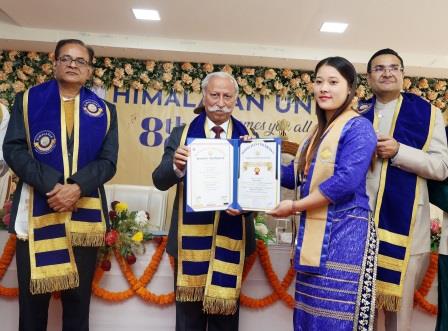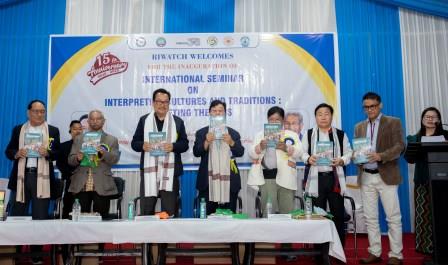-
SEC announces peaceful completion of vote counting in local body…
-
.jpg) BJP Arunachal Pradesh celebrates victory in local body elections
BJP Arunachal Pradesh celebrates victory in local body elections
-
.jpg) Governor interacts with NCC Cadets at training camp
Governor interacts with NCC Cadets at training camp
-
.jpg) National bodybuilding and fitness championship underway in Lower Siang
National bodybuilding and fitness championship underway in Lower Siang
-
BJP sweeps IMC elections; PPA aces PMC polls
-
 Governor attends Himalayan University Convocation
Governor attends Himalayan University Convocation
-
 Book on Traditional Festivals of Arunachal Pradesh released
Book on Traditional Festivals of Arunachal Pradesh released
-
Workshop on GIS and Remote Sensing
-
‘Yogananda Bhavan’ inaugurated at Ramakrishna Mission Narottam Nagar
-
Arunachal to participate in 9th Federation Cup Wushu Championship
According to a report released in March last, the number of internet users in India will reach 627 million by end of 2019, registering an 11 percent growth over 566 million users in 2018. Also it is now estimated that there are 251 million internet users in rural India currently and the figure is expected to touch 290 million by this year end. If the above figure speaks of a digital revolution sweeping the country, in Arunachal the story is somehow different as both connectivity and speed are the issues that are yet to be addressed with a comprehensive solution-oriented professional outlook. This is evident from the occasional outbursts from various quarters of the state’s populace and the most recent one has been triggered due to the below average quality of internet services in the state’s twin capitals, where it is expected to be the finest, by virtue of their administrative and financial importance.
Internet penetration and voice connectivity particularly via cellular handsets are one of the biggest happenings that had occurred in India during the last decade and it is encouraging to note that even the smallest towns and remotest of rural pockets have been included, thanks to increased accessibility at data rates calculated to be cheapest in world. Also, if internet is viewed as one of the best windows to access the world of information and knowledge, thereby making it an evolving tool of empowerment, the fact that there is a significant narrowing of gender gap in its access with women spending as much time on the internet as men in the country, must also be considered as nothing short of women empowerment.
One doesn’t need to be an IT specialist to conclude that a significant part of our daily activities are somehow related or dependent on internet and the list is growing day by day. It’s the demand of the digital age we are living to guarantee ceaseless internet connectivity and turning a deaf ear to it will only lead to be labelled as ‘backward’. And in state, the primary reason that is often singled out for internet failure is the damaging of Optical Fiber Cable (OFC) network due to construction of pathways of various dimensions. It’s a strange dilemma the state is facing when none of the two development activities can be sacrificed for the sake of the other, since both roads as well as internet are the recognised benchmarks of measuring infrastructural progress.
Besides taking a coordinated approach involving the stakeholders particularly to this aspect of the problem, a fresh relook of the whole scenario is also necessary acknowledging all the practicalities. It’s a ‘trouble shooting’ exercise the state will be awaiting with patience.
According to a report released in March last, the number of internet users in India will reach 627 million by end of 2019, registering an 11 percent growth over 566 million users in 2018. Also it is now estimated that there are 251 million internet users in rural India currently and the figure is expected to touch 290 million by this year end. If the above figure speaks of a digital revolution sweeping the country, in Arunachal the story is somehow different as both connectivity and speed are the issues that are yet to be addressed with a comprehensive solution-oriented professional outlook. This is evident from the occasional outbursts from various quarters of the state’s populace and the most recent one has been triggered due to the below average quality of internet services in the state’s twin capitals, where it is expected to be the finest, by virtue of their administrative and financial importance.
Internet penetration and voice connectivity particularly via cellular handsets are one of the biggest happenings that had occurred in India during the last decade and it is encouraging to note that even the smallest towns and remotest of rural pockets have been included, thanks to increased accessibility at data rates calculated to be cheapest in world. Also, if internet is viewed as one of the best windows to access the world of information and knowledge, thereby making it an evolving tool of empowerment, the fact that there is a significant narrowing of gender gap in its access with women spending as much time on the internet as men in the country, must also be considered as nothing short of women empowerment.
One doesn’t need to be an IT specialist to conclude that a significant part of our daily activities are somehow related or dependent on internet and the list is growing day by day. It’s the demand of the digital age we are living to guarantee ceaseless internet connectivity and turning a deaf ear to it will only lead to be labelled as ‘backward’. And in state, the primary reason that is often singled out for internet failure is the damaging of Optical Fiber Cable (OFC) network due to construction of pathways of various dimensions. It’s a strange dilemma the state is facing when none of the two development activities can be sacrificed for the sake of the other, since both roads as well as internet are the recognised benchmarks of measuring infrastructural progress.
Besides taking a coordinated approach involving the stakeholders particularly to this aspect of the problem, a fresh relook of the whole scenario is also necessary acknowledging all the practicalities. It’s a ‘trouble shooting’ exercise the state will be awaiting with patience.

Kenter Joya Riba
(Managing Editor)She is a graduate in Science with post graduation in Sociology from University of Pune. She has been in the media industry for nearly a decade. Before turning to print business, she has been associated with radio and television.
Email: kenterjoyaz@easternsentinel.in / editoreasternsentinel@gmail.com
Phone: 0360-2212313

